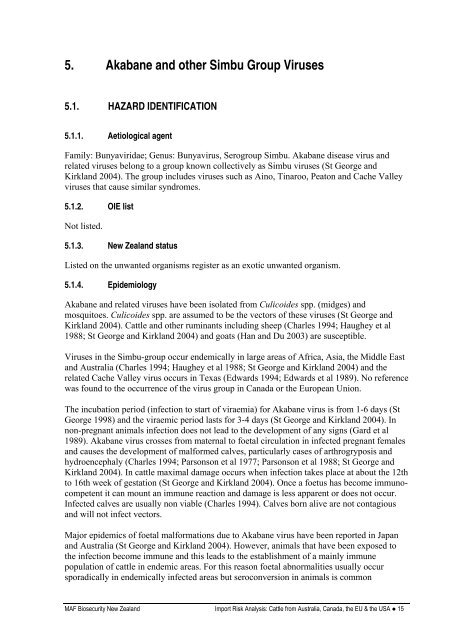Final Risk Analysis - Biosecurity New Zealand
Final Risk Analysis - Biosecurity New Zealand
Final Risk Analysis - Biosecurity New Zealand
You also want an ePaper? Increase the reach of your titles
YUMPU automatically turns print PDFs into web optimized ePapers that Google loves.
5. Akabane and other Simbu Group Viruses<br />
5.1. HAZARD IDENTIFICATION<br />
5.1.1. Aetiological agent<br />
Family: Bunyaviridae; Genus: Bunyavirus, Serogroup Simbu. Akabane disease virus and<br />
related viruses belong to a group known collectively as Simbu viruses (St George and<br />
Kirkland 2004). The group includes viruses such as Aino, Tinaroo, Peaton and Cache Valley<br />
viruses that cause similar syndromes.<br />
5.1.2. OIE list<br />
Not listed.<br />
5.1.3. <strong>New</strong> <strong>Zealand</strong> status<br />
Listed on the unwanted organisms register as an exotic unwanted organism.<br />
5.1.4. Epidemiology<br />
Akabane and related viruses have been isolated from Culicoides spp. (midges) and<br />
mosquitoes. Culicoides spp. are assumed to be the vectors of these viruses (St George and<br />
Kirkland 2004). Cattle and other ruminants including sheep (Charles 1994; Haughey et al<br />
1988; St George and Kirkland 2004) and goats (Han and Du 2003) are susceptible.<br />
Viruses in the Simbu-group occur endemically in large areas of Africa, Asia, the Middle East<br />
and Australia (Charles 1994; Haughey et al 1988; St George and Kirkland 2004) and the<br />
related Cache Valley virus occurs in Texas (Edwards 1994; Edwards et al 1989). No reference<br />
was found to the occurrence of the virus group in Canada or the European Union.<br />
The incubation period (infection to start of viraemia) for Akabane virus is from 1-6 days (St<br />
George 1998) and the viraemic period lasts for 3-4 days (St George and Kirkland 2004). In<br />
non-pregnant animals infection does not lead to the development of any signs (Gard et al<br />
1989). Akabane virus crosses from maternal to foetal circulation in infected pregnant females<br />
and causes the development of malformed calves, particularly cases of arthrogryposis and<br />
hydroencephaly (Charles 1994; Parsonson et al 1977; Parsonson et al 1988; St George and<br />
Kirkland 2004). In cattle maximal damage occurs when infection takes place at about the 12th<br />
to 16th week of gestation (St George and Kirkland 2004). Once a foetus has become immunocompetent<br />
it can mount an immune reaction and damage is less apparent or does not occur.<br />
Infected calves are usually non viable (Charles 1994). Calves born alive are not contagious<br />
and will not infect vectors.<br />
Major epidemics of foetal malformations due to Akabane virus have been reported in Japan<br />
and Australia (St George and Kirkland 2004). However, animals that have been exposed to<br />
the infection become immune and this leads to the establishment of a mainly immune<br />
population of cattle in endemic areas. For this reason foetal abnormalities usually occur<br />
sporadically in endemically infected areas but seroconversion in animals is common<br />
MAF <strong>Biosecurity</strong> <strong>New</strong> <strong>Zealand</strong> Import <strong>Risk</strong> <strong>Analysis</strong>: Cattle from Australia, Canada, the EU & the USA ● 15

















